Ehlers-Danlos Syndrome: You May Have It, Too
Who has never sprained an ankle? Sharp pain, swelling and discomfort for a few days… and then you are back to normal. But do you know that some people have to live with unstable joints, spraining their ankles repeatedly, getting bruised for no reason, unable to heal wounds properly? Meet Ehlers-Danlos syndrome.

The many-faced condition
Ehlers-Danlos syndrome (EDS) is a genetic condition that affects the formation of collagen, the most abundant protein in the body. Collagen is the main building material for our skin, tendons, walls of internal organs and blood vessels. There are quite a few genes responsible for building collagen, and in any of them something can go wrong; that’s why thirteen (!) different forms of EDS are identified, such as classic, hypermobility, and vascular(you can find the whole list here). EDS may affect around 1 in 5000 thousand people, perhaps many more. It is still little known among doctors; thus, it may be vastly underdiagnosed. In most cases, it is inherited, though many people only carry it without experiencing any symptoms.
Warning signs
EDS symptoms vary depending on the form, but here are some of the most common:
- Very mobile, flexible joints
- Unstable joints that frequently get injured (ankles, knees)
- Skin that gets bruised very easily, elastic skin
- Cuts heal slowly and leave scars
- Popping and clicking joints
- Joint pain
- Capillaries (small blood vessels) break easily
If you recognize yourself in these symptoms (you can find a more complete list here), you may want to get tested for EDS. Tests include genetic analysis of a blood sample and skin biopsy. However, be prepared that your doctor has never even heard of EDS!
Risks and treatment
Normally, EDS is not life-threatening, except for its vascular form, which can lead to rupture of internal organs (especially while giving birth). However, even classic EDS can be a great nuisance: it can mean an early onset of osteoarthritis, plus all those torn tendons, bruises, scars… You will need to take great care with your joints, wear knee and ankle braces while doing sports, and perhaps abstain from wearing high heels.
So far, no cure exists for EDS, but a novel nutritional approach may show the way forward. A 2006 study points out that many apparently genetic disorders can also be caused by nutritional deficiencies; therefore, a diet that promotes the building of collagen can potentially help treat EDS. We have already written about natural ways to boost collagen. Let us list a few supplements that, when taken together, can help treat EDS, according to the abovementioned study:
- Vitamin A (retinol) – found in milk, dairy, meat (especially liver)
- Vitamin C (peppers, cauliflower, kale, kiwis, oranges)
- Vitamin K (leafy greens, cabbage, cucumbers)
- Carnitine (cod and other fish, chicken, beef)
- Magnesium (beans, nuts, leafy greens)
Of course, this kind of nutritional therapy for EDS is still experimental, but it definitely won’t hurt you. Remember, however, that there are many other disorders that can have symptoms very similar to those of EDS, so don’t just diagnose yourself – make sure you do all the necessary tests first!






Hey! Actually it’s being understood that EDSer’s (like myself) have a lot of food ALLERGIES amd there are immune responses. Gastrointestinal and respitory issues galore, and that is my life too. Injuries are one thing, but things like dairy can really make us sick. Zinc appears to be incredibly important, as there is commonly deficiency in THAT department, and magnesium & B vitamins in the mix to help with that bone & tissue composition. You need nutrients to work together, and things like wheat and dairy can mess that up. Thanks for listening! Here’s to learning more about a widespread disease that is most likely very common, just undiagnosed and misunderstood…